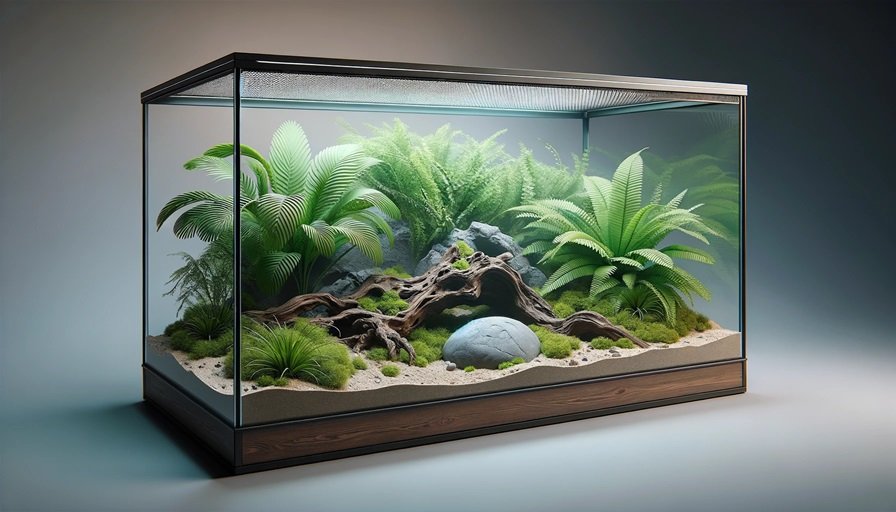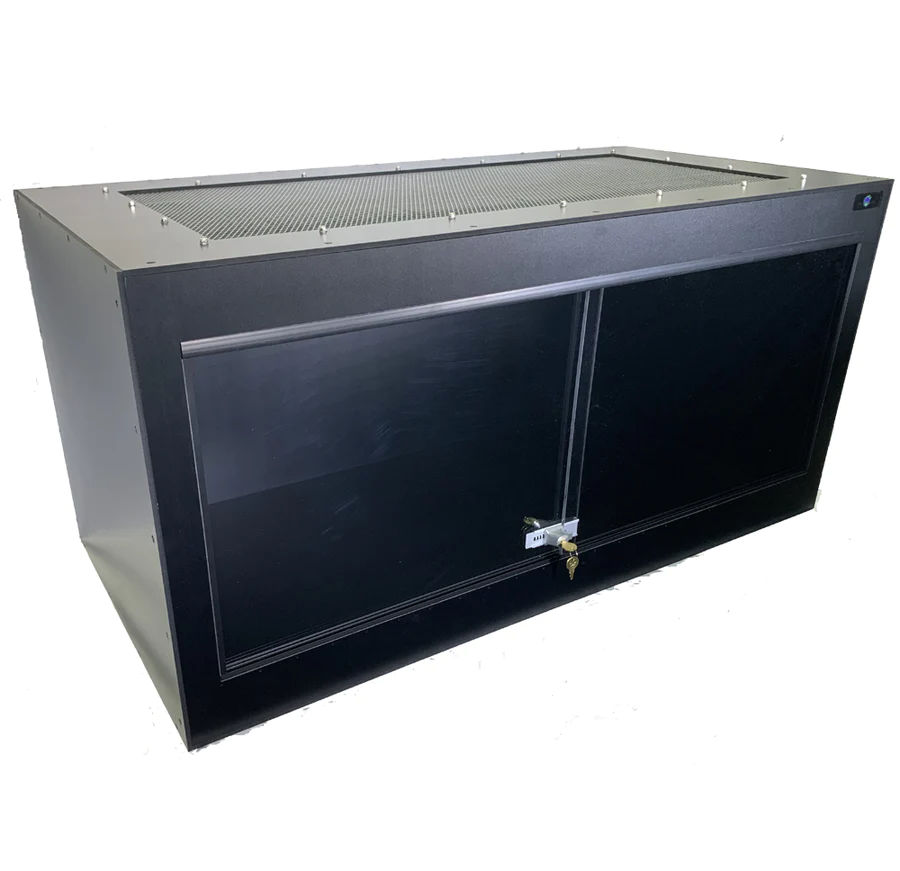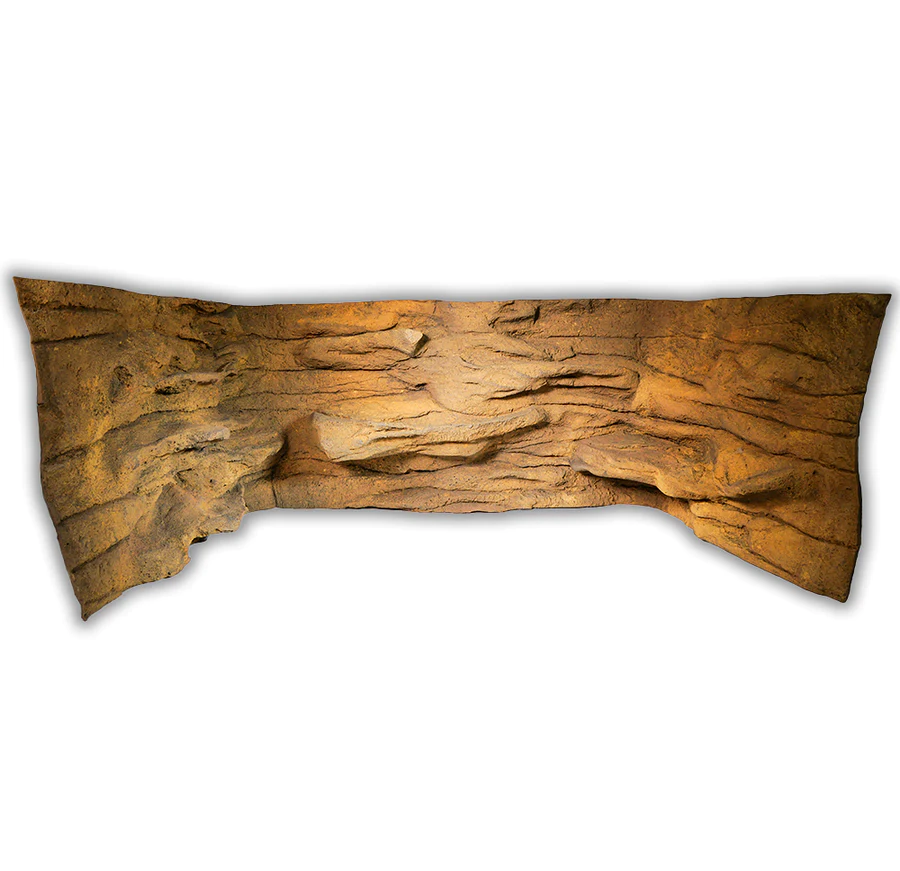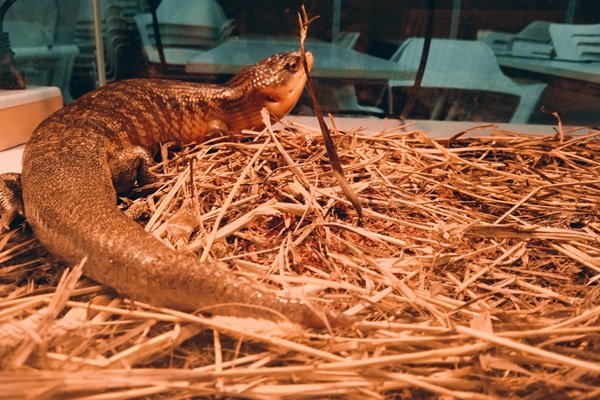Blue tongue skinks are unique and fascinating pets, known for their distinctive blue tongues, triangular heads, and robust bodies. Providing a comfortable and stimulating environment is essential to ensure your pet skink thrives. In this guide, you will learn how to create the ideal blue tongue skink habitat for a happy, healthy skink. We will cover all aspects of terrarium setup for skinks, including enclosure size, temperature gradients, humidity, and lighting. Discover the essentials for a pet lizard environment that allows your blue tongue skink to flourish.
Whether you are new to skink care or an experienced reptile enthusiast, this skink care manual will get you started or provide you with some tips on improving your existing setup.
Fundamentals for a Blue Tongue Skink Enclosure:
- Provide a minimum of 8 square feet of floor space in the enclosure to allow for activity and exploration.
- Maintain proper temperature gradients with distinct basking and cool zones, essential for the health of your skink.
- Monitor and adjust humidity levels in accordance with the specific species of your blue tongue skink.
- Choose high-quality UVB lighting and ensure its correct placement for optimum health benefits.
- Consider front-opening enclosures for better access, interaction, and skink safety.
- Regularly monitor temperatures and humidity levels to ensure optimal conditions for your pet skink.
- Provide environmental enrichment for mental stimulation and a happy, healthy blue tongue skink.
Understanding Blue Tongue Skink Basics: Behavior and Appearance
Blue tongue skinks, or Tiliqua spp., are recognized for their striking appearance, characterized by heavy, torpedo-shaped bodies, short legs, and their vibrant blue tongues. These fascinating reptiles exhibit various engaging behaviors that set them apart from other pet lizards.

“Blue tongue skinks are diurnal and terrestrial, making them attractive pets for many reptile enthusiasts.”
As omnivorous reptiles, blue tongue skinks consume a diverse diet, eagerly eating insects, slugs, small animals, and plant matter. However, these captivating reptiles require a balanced nutritional plan to ensure they thrive in a captive environment. Their activity levels and curiosity often display the need for environmental enrichment and mental stimulation.
- Stress-free habitat: Establishing a comfortable and well-designed enclosure will reduce stress and encourage natural behaviors, such as basking, burrowing, and exploring.
- Balanced diet: Supplying a variety of protein sources, fruits, and vegetables fulfills their nutritional needs, promotes growth, and supports overall health.
- Enrichment: Providing items like climbing branches, hiding spots, and foraging areas will contribute to mental well-being and keep the skink active and engaged.
Blue tongue skink behavior can provide insight into their overall health and well-being. Some key indicators that your pet lizard is happy and healthy include:
- Regular eating habits
- Active exploration of their enclosure
- Proper shedding, with no retained skin
Monitoring your blue tongue skink’s appearance and behavior is essential in providing optimum reptile care. By paying close attention to their diet, habitat, and activities, you can ensure that your captivating pet thrives in its captive environment.
Choosing the Right Terrarium Size for Your Blue Tongue Skink
Providing the proper terrarium size blue tongue skinks require is crucial to creating a healthy and comfortable environment for your pet. This involves understanding the appropriate space needed for an active reptile habitat, and the benefits of front-opening enclosures. In this section, we will discuss the importance of adequate skink space requirements and the many advantages of using a front-opening reptile enclosure.

Why Floor Space Matters for an Active Reptile
Blue tongue skinks are notably active reptiles that benefit from a spacious habitat to move about and explore. Providing at least 8 square feet of unobstructed floor space is essential to accommodate their physical activity and satisfy their natural curiosity. A larger enclosure allows skinks to exhibit a range of behaviors and contributes significantly to their overall quality of life.
A well-designed enclosure ensures pet skink safety and promotes a healthy lifestyle for these active reptiles.
The Benefits of Front-Opening Enclosures
Using a front-opening enclosure streamlines reptile habitat access, making it easier to interact with your skink, perform routine maintenance and insert enrichment elements like hiding spots and climbing branches. Some key benefits of front-opening enclosures include:
- Accessibility: Easy access to clean and feed your skink as well as handle it with care.
- Security: Secure latching mechanisms prevent skink escapes, accounting for their strength and intelligence.
- Connection: A well-constructed enclosure placed in a central area of the home encourages observational engagement, fostering a connection between the skink and its owner.
To create an escape-proof skink enclosure, ensure the latches and seals are strong and secure, and that there are no gaps larger than your skink’s head to prevent accidental escapes. Additionally, providing ample floor space in a front-opening enclosure will enhance the well-being of your pet skink and contribute to a happy, healthy life.

Evolution 4 PVC Enclosure 2.0
48 L x 24 W x 24 H
Proper Lighting and UV Exposure for Optimal Health
Blue tongue skinks require proper UVB lighting and bright white light to simulate natural sunlight, which is vital for their survival. As diurnal reptiles, they need exposure to high-quality UVB lighting to maintain optimal health and well-being. Appropriately positioning the UVB light source, either unobstructed or considering mesh, is crucial for delivering the necessary UV exposure.
To achieve this, use bulbs that span at least half the length of the enclosure on the warm side. The recommended bulbs for this purpose are a T5 10.0 or 12% bulb. Placing these bulbs at specific distances from the basking platform ensures proper UVB absorption, which greatly influences the skinks’ physiological health.

UVB lighting is necessary for blue tongue skinks’ survival and overall health. Position the light source correctly to provide ample exposure for your diurnal reptile.
Managing the UV index for skink health is also essential. To create a suitable environment for your blue tongue skink, consider the following skink lighting requirements and guidelines:
- Install UVB light sources at a proper distance from the basking surface to ensure the skink receives the necessary wavelength for its wellbeing.
- Place the light source on the warm side of the enclosure to provide a natural basking area for the skink.
- Monitor the UV index regularly and replace UVB bulbs every six months to ensure consistent UV exposure.
- Don’t obstruct the UVB light source with opaque materials, but rather, use mesh or other semi-transparent mediums that allow for optimal UVB penetration.
- Ensure proper light timing by simulating a natural day/night cycle with timers on your light fixtures. Blue tongue skinks typically require 12 to 14 hours of light per day.

Reptile Terrarium Background
3 Foot 3 Sided
Creating a Temperature Gradient in Skink Enclosures
Establishing a temperature gradient in skink habitat is vital for blue tongue skinks to thermoregulate. The gradient should include a basking surface with temperatures ranging from 105-115°F and a cooler zone at 70-80°F. Proper basking regions are typically achieved with 100w PAR38 halogen bulbs, whereas a cooler zone ensures a skink can reduce its body temperature as needed.
How to Set Up Basking and Cool Zones
- Create a basking zone with a heat lamp positioned over a raised basking platform. This zone should achieve a surface temperature of 105-115°F, enabling skinks to efficiently regulate their body temperature. Make sure the heat lamp is of proper wattage and safely set up to prevent accidents.
- Establish a cool zone on the opposite side of the enclosure, allowing your skink to escape the heat when necessary. Make sure the temperatures in this area range between 70-80°F, helping your pet in regulating skink body temperature.

You can use a plug-in lamp dimmer to adjust the intensity of the heat lamps for skinks, providing precise control over the temperature levels in the enclosure.
The Importance of Monitoring Enclosure Temperatures
Continuous monitoring of the enclosure’s temperatures is essential to guarantee a skink’s health and comfort. Employing technology like infrared thermometers for the basking surface and digital probe thermometers for passive tracking helps maintain appropriate temperatures across the enclosure. Adjusting heat sources with devices like plug-in lamp dimmers can tailor the habitat’s climate to the precise needs of the skink.
| Tools for Temperature Monitoring | Usage |
|---|---|
| Infrared Thermometers | Measure temperatures at the basking surface |
| Digital Probe Thermometers | Monitor ambient temperatures throughout the enclosure |
| Plug-in Lamp Dimmers | Adjust intensity of heat lamps, allowing fine-tuning of temperatures |
In conclusion, a proper temperature gradient in a blue tongue skink’s enclosure is crucial to ensure their overall health and well-being. Establishing a basking zone and a cool side in the enclosure will provide your skink with necessary options for thermoregulation. Utilizing tools like infrared thermometers, digital probe thermometers, and plug-in lamp dimmers will aid in monitoring skink enclosure temperatures and making necessary adjustments.
Maintaining Ideal Humidity Levels for Different Skink Species
Different blue tongue skink species have varying humidity requirements, playing a crucial role in their overall health, comfort, and successful shedding. Taking into account your specific skink’s origins, whether Australian or Indonesian, is essential when determining appropriate humidity levels for their enclosure.
Australian skinks typically thrive in lower humidity levels, around 30-40%, while Indonesian species require higher humidity at 60-80%. Maintaining these ideal levels helps prevent issues related to shedding and fosters a more comfortable and healthy environment for your pet skink.
To achieve and maintain proper humidity within your skink’s enclosure, consider using tools such as hygrometers for accurate humidity tracking. Additionally, strategic placement of water dishes, misting with water, and incorporating moisture-retaining substrates can all contribute to achieving the desired humidity levels. Regular monitoring and modifications are crucial to ensuring the well-being of your blue tongue skink and helping them thrive in their habitat.
Blue Tongue Skink Enclosure FAQs
What is the ideal size for a blue tongue skink enclosure?
The enclosure for an adult blue tongue skink should have a minimum of 8 square feet of floor space. This size allows the skink to explore and engage in regular physical activity, enhancing their quality of life.
What type of lighting is necessary for a blue tongue skink enclosure?
Blue tongue skinks require bright white light and high-quality UVB lighting to simulate natural sunlight. Using a T5 10.0 or 12% bulb that spans half the length of the enclosure on the warm side ensures proper UVB absorption, which is crucial for the skinks’ physiological health.
How should I set up a temperature gradient in a blue tongue skink enclosure?
Create a temperature gradient with a basking surface temperature of 105-115°F and a cooler zone at 70-80°F. You can achieve proper basking temperatures using 100w PAR38 halogen bulbs and provide a cooler zone where the skink can reduce its body temperature when needed.
What tools can I use to monitor temperature in my skink’s enclosure?
Infrared thermometers can be used to monitor the basking surface temperature, while digital probe thermometers are ideal for passive tracking of temperatures across the enclosure. Plug-in lamp dimmers can help adjust heat sources to meet your skink’s specific needs.
How do humidity requirements vary for different blue tongue skink species?
Australian skink species generally thrive in moderate humidity levels, while Indonesian species require higher humidity levels. Maintaining appropriate humidity levels in the enclosure can influence a skink’s overall health, including proper shedding.

